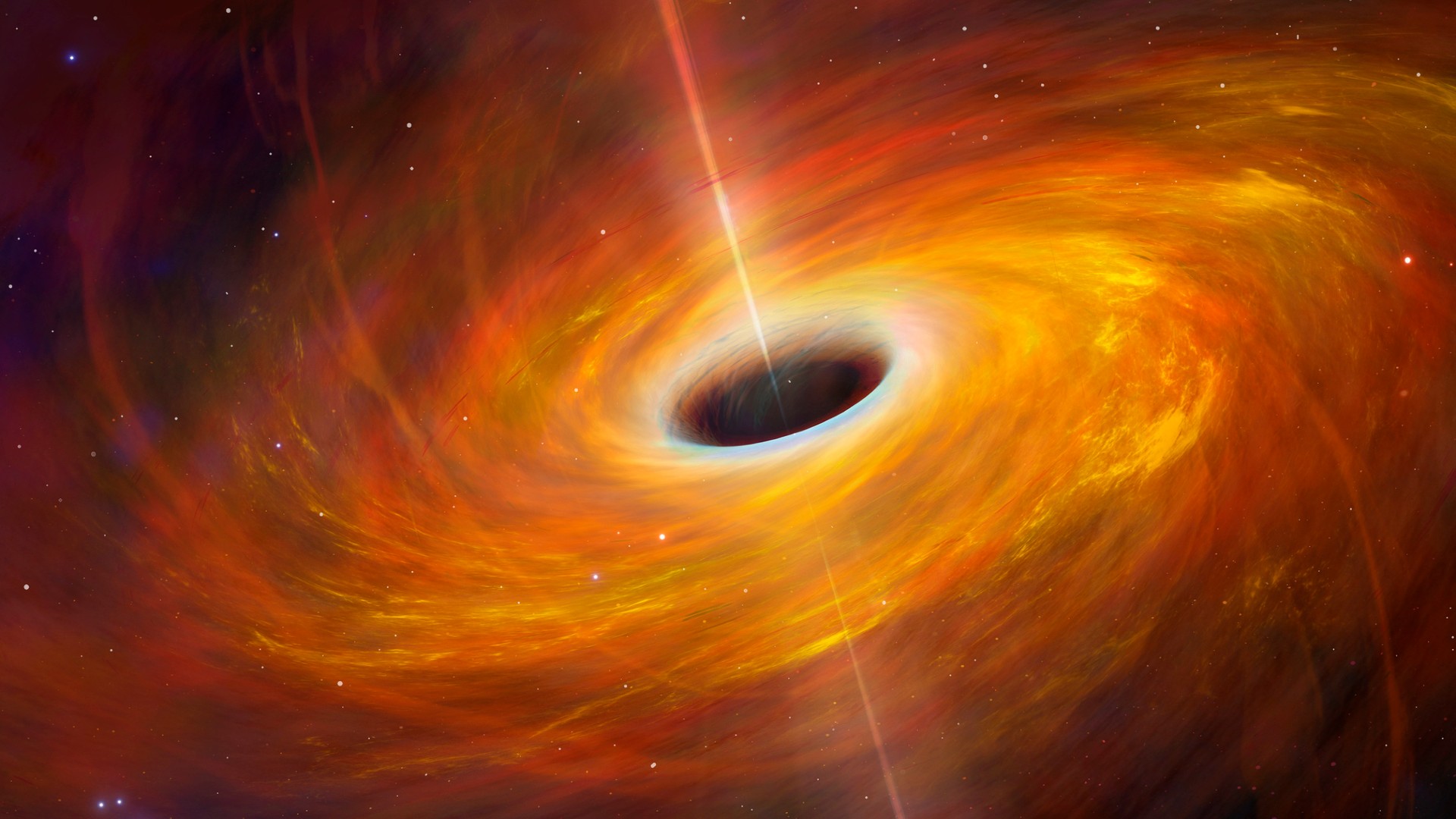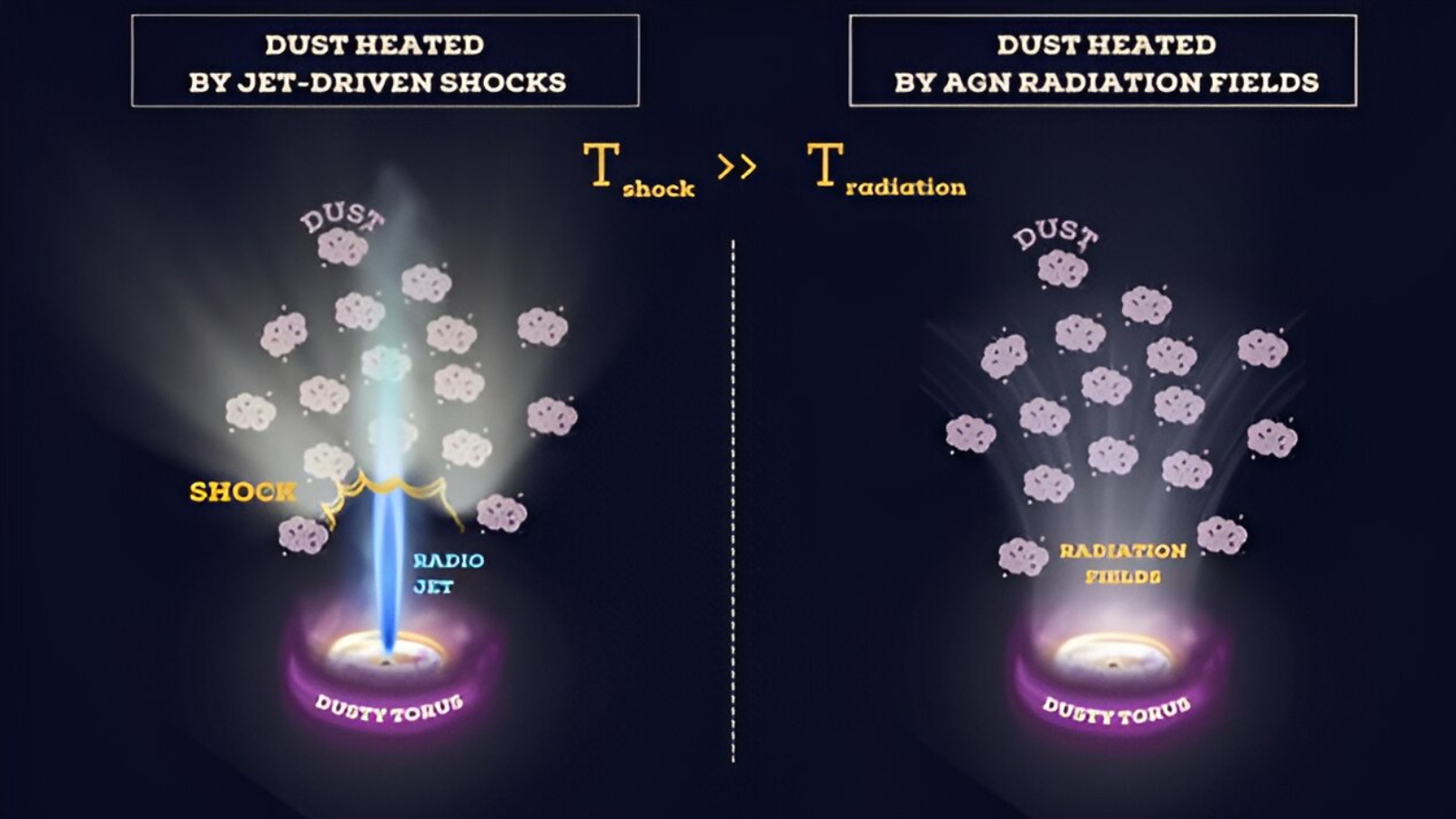Astronomers used the James Webb Space Telescope (JWST) to image the structure of dust and gas surrounding a distant supermassive black hole, and discovered the signature of a literal “shock.”
The team discovered that the energy heating this swirling cloud of gas and dust actually comes from collisions, or “shock waves,” with jets of gas traveling close to the speed of light — an unexpected development, since scientists had previously theorized that the energy heating the dust came from the supermassive black hole itself.
The galactic home of this supermassive black hole is the active galaxy ESO 428-G14, located about 70 million light-years from Earth. The term “active galaxy” means that ESO 428-G14 has a central region, or “active galactic nucleus” (AGN), that emits powerful and intense light across the entire electromagnetic spectrum due to the presence of a supermassive black hole that is voraciously devouring the material around it.
This striking AGN discovery was achieved by members of the Galactic Activity, Torus and Outflow Survey (GATOS) collaboration, which is using dedicated JWST observations to study the centres of nearby galaxies.
“There’s a lot of debate about how AGNs transmit their energy to their surroundings,” David Rosario, a senior lecturer at Newcastle University and member of the GATOS team, said in a statement. “We didn’t expect radio jets to cause this kind of damage, but here we are!”
Related: Dark matter could play the role of “matchmaker” for supermassive black holes
Unlocking the secrets of ‘noisy’ black holes
Every large galaxy is thought to have a supermassive black hole at its center, with a mass between millions and billions of times that of the Sun, but not all of these black holes reside in AGN.
Take the Milky Way, for example: our galaxy’s supermassive black hole, Sagittarius A* (Sgr A*), is surrounded by so little matter that its “diet” of matter is equivalent to a human eating one grain of rice per day. a million years. With a mass equivalent to about 4.3 million suns, Sgr A* is a “quiet” black hole, but it certainly has some noisy neighbors.
Consider the supermassive black hole at the center of the galaxy Messier 87 (M87), about 55 million light-years away. This black hole, M87*, is not only much larger than Sgr A*, at about 6.5 times its mass; a billion It is surrounded by, and feeds on, a great deal of gas and dust, as well as the Sun.
Because this material has angular momentum, it cannot fall directly into M87*, so it forms a flat cloud of gas and dust that swirls around the supermassive black hole, called the “accretion disk,” and is gradually fed into the black hole.

Supermassive black holes don’t just sit passively in their accretion disks, waiting to be fed, like cosmic babies in highchairs: the immense gravitational influence of these cosmic giants creates enormous tidal forces on the accretion disk, heating it up to temperatures of 18 million degrees Fahrenheit (10 million degrees Celsius).
This causes the accretion disk to shine brightly, powering some of the AGN’s illumination.The immense gravitational influence of these space giants creates enormous tidal forces on the accretion disk, causing it to heat up to 18 million degrees Fahrenheit (10 million degrees Celsius).
But that’s not all.
Like a misbehaving toddler, not all of a supermassive black hole’s “food” makes it into its “mouth”: Strong magnetic fields direct some of the material in the accretion disk toward the poles of the black hole, accelerating these charged particles to nearly the speed of light in the process. It’s just like your child throwing food at you.
From both poles of the black hole, this material erupts outwards in parallel celestial jets, which are accompanied by the emission of light across the electromagnetic spectrum, but are particularly powerful in the radio wave range.
As a result of these contributions, AGNs can become very luminous, sometimes brighter than the combined light of all the stars in the surrounding galaxy.

The dust surrounding an AGN often absorbs visible light and other wavelengths of electromagnetic radiation, obscuring their center from view, but infrared light can slip through the dust, and conveniently, JWST observes the universe in infrared light, making this powerful space telescope the perfect tool to peer into the heart of an AGN.
When the GATO team carried out this study in ESO 428-G14, they found that dust near the supermassive black hole spreads along the jets, revealing an unexpected connection between the jets and the dust, and suggesting that these powerful outflows may be responsible for both heating and forming the dust.
Further study of the relationship between jets and dust around supermassive black holes could shed light on the influence of these cosmic giants on galaxy formation, as well as how material is recycled within AGN.
“It’s incredibly exciting to have the opportunity to work with JWST’s exclusive data and access these amazing images before anyone else,” said Huda Haider, a PhD student in Newcastle University’s School of Mathematics, Statistics and Physics. “I feel incredibly lucky to be part of the GATOS team and it’s a real honour to be working closely with leading experts in the field.”
The team’s research was published in the journal Monthly Bulletin of the Royal Astronomical Society.







